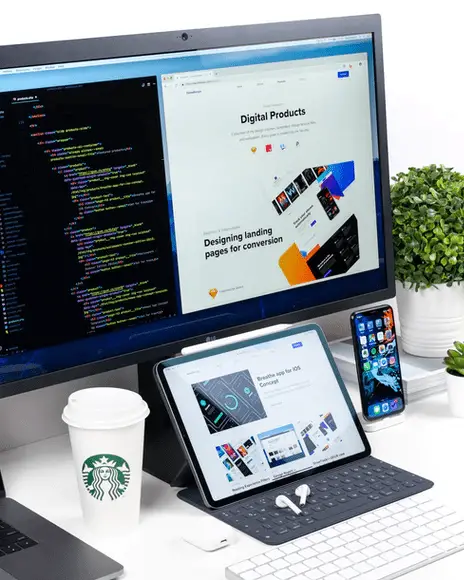
Source
Living in a fast-paced world, we observe changes in every aspect of our lives, from education and health care to art and science. And clearly, such changes are also imminent in the web design field.
In fact, with rapid technological advancement, web design has undergone tremendous changes. Not only has the industry become more effective, but it is also now much more accessible.
However, just like any other area, web design requires keeping an eye on new trends and changes to make sure your business tailors to customers’ needs.
But is it possible to be ahead of the market alterations and know what’s yet to come? The answer is somewhat ambiguous. Some changes are transcendental, and we can’t forecast them until they occur. Still, there are things we can predict. From the extensive use of a proficient design palette to enhanced security, the future of web design is striking and vigorous. Let’s look at other elements we can expect to observe.

Factors that influence web design
Many factors determine the course web design follows. However, the next three factors seem to be the most potent and worth consideration.
- Dynamic client preferences: Clients are driving power for the field to advance. Without the customers, web design is unlikely to improve. People define what they like and want to see, and, naturally, their preferences change throughout the years. Web design specialists study such changes in people’s behavior and adhere to their expectations.
- Fundamental changes in the market: Market is another element that dictates changes in web design. Digital marketing, SEO, and social media play a pivotal role in web design, and when they go through changes, web design will likely upgrade, too.
- Enhanced technologies: As said earlier, technologies develop speedily, simplifying our lives. New apps, hardware, chips, devices – they all influence web design. Moreover, such advancements touch upon every web design professional sooner or later. Otherwise, it will negatively influence the quality of their work.
Having learned that, can we predict any coming change? We can envisage plenty of changes the web design industry will undergo in the near future. Below are a few of them.
More practical design tools, approaches, strategies
Since technologies are fluid, we can say that what is used now in web design will soon become a thing of the past. Various tools will get updated, and experts will have to switch to them to provide the best user interface. Other than that, we should be ready for changes in methods and strategies that specialists will use to tackle various tasks.
Better responsiveness and experience
Although demanding and seldom seen now, web pages will transform impressively in the future. Besides automatically adjusting fonts and other elements to users’ devices, the overall experience will be much more pleasant. Also, web design will be more intuitive and user-friendly.
Stronger emphasis on interactions
Maintaining customer engagement will be a top priority in web design. Since people’s attention span constantly shrinks, design experts will need to come up with ways to catch users’ curiosity, more so, to make interactions stress-free, brisk, and meaningful. Specifically, professionals will broadly employ chatbots and other new ways of immediate user interaction.
Wider use of Machine Learning and Artificial Intelligence
AI and ML have been at the forefront of technological changes, showing incredible progress and helping other areas develop. And although these are already being implemented in web design, their role in bringing in new customers will only strengthen in the future.
Unparalleled security
Even though security is primarily the concern of programmers, it doesn’t mean web designers won’t be engaged with it. Experts will have to cooperate with coders and slog away to ensure design elements preserve overall security.

Far-reaching simplicity
Tendencies show that users start longing for simple web pages, so web design will have to gravitate toward simplicity. Besides sticking to vibrant but straightforward design patterns, specialists will create scrollable pages to ensure smooth, streamlined content.

Accessible AR and VR
Augmented Reality and Virtual Reality are promising technologies that appeared long ago. And although they were told to be widely used in various areas, it didn’t happen for some reason. Yet, it doesn’t mean they haven’t proved ineffective. Their time is to come, and web design will be among those fields to apply the technologies.
Unprecedented speed
Speed is another change in web design we can predict experts will pay close attention to. Technology development will boost processing and rendering, which, in turn, will improve speed and allow web designers to include better and more novel items in websites. That will also mean quicker loading of elements.
Continuous development
Some of the mentioned changes might occur soon; others might happen later. While it’s hard to predict the exact timing, it’s more important to state that changes are unavoidable. And such alterations will eventually touch upon any web design branch and approach.
Are you ready for the future?
Forewarned is forearmed, i.e., the sooner you learn the niche and its ins and outs, the more elements you will be able to predict in the future. Provided are just a tip of the iceberg of alterations web design might experience shortly. Nonetheless, knowing them and being ready to face them will help you adjust to people’s requests more quickly, thus outperforming your competitors.